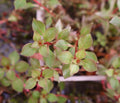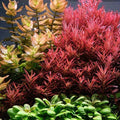The Basics and the Simplicity of Aquascaping
The art of creating landscapes in aquariums is known as aquascaping. In contrast to the traditional fish tank, the emphasis in aquascaping is primarily on the placement of rocks and wood (referred to as "hardscape") and plants (referred to as "softscape").
The goal is to recreate a modest scene from the actual world, such as a solitary tree in a woodland clearing, in miniature and underwater using objects like stones, wood, moss, and aquatic plants.
Making an Aquascape
On the internet, there are many groups and resources related to aquascaping. I want to provide you with a brief and straightforward introduction to the essential elements and prerequisites in this post so you can decide if you want to start developing your own "environment." Since aquascaping undoubtedly involves some work and expertise,
The ability to begin with very basic and simple setups that need little effort to construct and maintain yet are incredibly attractive and intriguing to look at is what has made aquascaping so popular in recent years. It is a little area of the natural world with a distinct ecology.
If there are any creatures there, like prawns or snails, you will be shocked at how much activity there is. However, simple plant aquascapes may be fascinating to construct and to see, such as those in the Japanese Iwagumi style, which was influenced by the well-known zen stone gardens.
What You Must Understand
Before choosing to construct your own aquascape, there are a few things you should be aware of if you are a fan of simplicity.
It demands dedication and time.
While prawns and snails may contribute to keeping the aquarium clean, they can't accomplish the whole job.
Cleaning and maintaining your aquascape and its components will take some time from you (about one hour each week). If you don't put in that time, algae can quickly take over your aquascape, causing suffering and maybe even killing your plants and animals.
So be sure you dedicate that hour each week. You'll need to clean the aquarium, its parts, and trim back the plants as needed. You must do a water change once a week in an aquarium since it is a confined environment without access to fresh water, which lowers the amount of chemicals produced by animals and dead plant components. It is advised to take about half the water out and replace it with new water that is at room temperature.
It Needs a Permanent Location
As you add more stones, the tank will get heavier, so it needs a strong, permanent place to sit.
A tiny aquarium with 30 liters of water and extra hardscape has quite a bit of weight, so keep that in mind as well. It will thus be difficult to relocate after it has been created.
In order to avoid having to go through the difficult process of transferring an aquascape, choose a nice location in advance and wait if you intend to relocate.
It Calls for Endurance
Low water levels during the first several weeks of a "dry start" offer ground plants time to develop stronger roots.
Last but not least, you need to understand that aquascaping takes a lot of patience. It takes weeks or months, especially right after you set up your aquascape, before the plants are growing properly, the first algal period is past, and you can truly start to appreciate what you have created.
It takes time for environmental changes to take effect, such as changing the amount of light or adding water. And until you are satisfied with the outcome, it takes time and a lot of trial and error.
Aquascaping Techniques
Diverse techniques and aesthetics are available in aquascaping. Every individual has a niche, as well as expectations and desires for their particular aquariums. There are four main types of aquascaping, and each has distinctive qualities and traits of its own: Dutch, Jungle, Iwagumi, and Nature styles are some examples of fashion. A brief description of these four basic types is provided below.
Dutch Aquarium
The Dutch aquascaping design, which gained popularity in the 1930s, is entirely centered on the cultivation and placement of aquatic plants. Hardscape materials, such as driftwood, are not used in the Dutch design. The terracing approach is the fundamental building method, and the main emphasis is on the height, color, and texture of a wide variety of plants. Although it may seem simple to do, aquascapers require a broad understanding of a variety of plants to produce an appealing aquascape.
Tropical Aquarium
The Jungle Aquarium is among the easiest aquascaping designs to replicate. The completed item should have the untamed, wild appearance of a jungle, as suggested by the name. One of the most typical features of Jungle tanks is that the vegetation can grow at its own pace and get quite dense, requiring less upkeep and extending the design's lifespan.
The aquascape in the jungle style may not have the most intricate design. Even so, as many fish species prefer its environment of dense vegetation, it has the potential to develop into something beautiful and useful over time.
Iwagumi Aquascaping
The Iwagumi aquascaping style is based on an arrangement of rocks as the hardscape, with their precise positioning using the golden ratio, as opposed to the Dutch style, which only uses plants. Low-growing plants are frequently used to enhance the beauty of the natural world. Three primary stones, one larger one known as the "big Buddha," and two smaller ones, are typically used in an Iwagumi aquascape. The use of stones with the same color and texture is crucial to achieving a sense of harmony and uniformity in the tank.
Biological Aquarium
The Nature Aquarium Style, which distinguishes itself from the meticulous Dutch style, strives to evoke a sense of the natural world. Nature aquarium aquascapes frequently feature scaled-down replicas of mountains, slopes, valleys, and rain forests. Plants and hardscape components both contribute significantly to the aquarium's attempt to achieve equilibrium.
Aquascape Nano
The Nano aquascape style is one of the most well-liked freshwater tank designs. A tiny aquarium would look wonderful with this lovely tank layout. Therefore, aquascaping in the Nano style is enjoyable and gratifying, whether you prefer smaller tank displays or are working with a restricted amount of space. Additionally, hobbyists who choose this lovely aquascape design benefit from lovely plants and teeming schools of smaller fish.
















